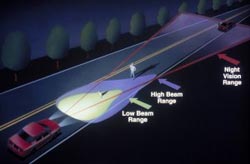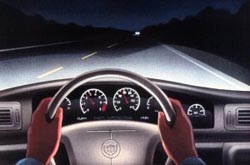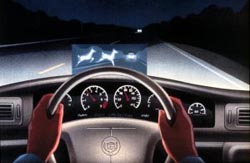
Cadillac Night Vision
Greed & Speed Are Good
The night. Mystical. Terrifying. Romantic. Unknown. More adjectives have been created to explain our problematic relationship with the absence of the sun than almost any other human experience. So what does it mean for human evolution when night becomes day and the midnight darkness becomes as visible as noon? To find out, slip behind the wheel of a 2000 or 2001 Cadillac equipped with Raytheon's Night Vision system. Dark lonely roads suddenly yield up their secrets to the all-seeing magical eye embedded in the center of the big Caddy's front grille. This remarkable system uses thermal night vision technology that cost Raytheon $100 million to bring from the harsh Desert Storm battlefield to the cosseting leather cabin of a big rolling DeVille. A small rectangular heads up display on the driver 's lower windshield reveals sights and images that otherwise would not be possible to see, even with high beams blaring. What began as a DoD "black program" of the 1970's is now cutting a hole through the new millennium midnight blackness.
In 1996 Cadillac approached Raytheon and said it was going to be rejuvenating its Florida retiree brand image and was mightily moving forwards to the golden glory days of its engineering heyday past, and that meant bringing cutting edge cars to the new netizen consumer. Night vision seemed like a perfect way to epitomize Cadillac's brand renewal techno-ambitions. But unlike $10,000 Pentagon-inspired toilet seats, this new rolling technology wunderkind had to be small, cheap, and maintenance-free for 10 years and/or 100,000 miles. Four years later, the $1995 option cost result was a barely discernible, shatterproof, thermal imaging sensor nestled in the bulls eye center of an all matte-black grille. A small bulge on top of the driver instrument binnacle houses the system's associated heads up display (HUD).
Cadillac Night Vision is actually a thermal system, not "night vision" system. In typical night vision systems, any available light, such as from the moon, is amplified 20,000 times or more. This also means that if a bright beam suddenly swings your viewing way, it will cause the amplifying sensors to produce a flaring "whiteout." Obviously, this is not a good thing when driving down a road with cars coming at you with front halogens flaming.
But a thermal imaging system doesn't have this object obliterating flare problem. Night Vision uses a refractive optical-lens system to gather infrared energy (IR). The grille-mounted sensor views the onrushing road through an infrared-transparent window approximately three inches in diameter. This little window looks like a small spherical camera and protects the optics, as well as gives a durable surface to clean. The grille positioned device also incorporates an internal heater to prevent snow and ice build-up on its small front window as the car plows through dead of winter slush. Just behind this "camer" window, refractive optics are used to focus infrared energy on a 1-inch-square detector. The Night Vision system can detect thermal temperature differences in objects as small as 1/3 of a degree. Information from this sensitive and well-protected detector is passed to sensor electronics that translate the data into a reversed (negative) black and white image presented on the HUD. Raytheon Systems Co. developed the Night Vision sensor, while Delphi-Delco Electronics developed the HUD for the Night Vision system.
More technically, the Night Vision infrared imaging system works with an uncooled focal plane array (UFPA) detector for the sensor and ties into an active matrix liquid crystal display for the HUD. This pyroelectric detector has also been used for military and commercial applications. The detector consists of a barium strontium titanate reticulate structure bonded to a readout integrated circuit. The detector temperatures are stabilized with thermoelectric coolers for peak performance, but there is no attempt to achieve cryogenic temperatures. It's basically a room temperature system.
Each reticulated section corresponds to a single IR detector pixel. The UFPA is 320 infrared sensing elements wide by 240 infrared sensing elements tall. These elements individually respond to the thermal energy emitted by objects in the road scene. Each sensing element is a temperature-dependent capacitor that changes capacitance depending on how much IR it is receiving. A chopper disc rotates in front of the detector to modulate the scene's energy by allowing the pixels to constantly blank on and off. The disc rotates in phase with the detector read-out circuitry timing. The circuit under each element samples capacitance on a regular basis, and these readings are converted into a monochromatic video signal that is imaged on the driver HUD. Significantly, from a maintenance and longevity perspective, no mechanical scanner is required to serially trace out object space to produce the HUD image. Instead, each pixel of the UFPA detector "stares" out into space continuously, the scene energy is modulated, and the road image is then produced in its totality by electronically scanning (reading out) the whole detector array at once.
In the end, though, it's all really just a video camera, but a camera that shoots its thermal footage in the invisible to the human eye infrared (IR) realm. Every object in the universe emits IR if its temperature is above absolute zero. The amount of radiation emitted depends on two things: the temperature of the object and its emissivity. Moreover, objects that are the same temperature can also emit IR at different rates. Intercepting the radiation from various objects in space and focusing this radiation onto IR detectors produces thermal images that can be displayed for the wavelength challenged human eye to see.
The otherwise invisible infrared spectrum begins at a wavelength of approximately 0.75 microns and runs to 1000 microns. Because the IR energy must pass through the atmosphere to get from the source to the car's detector, its infrared imaging system uses the ranges of IR energy that travel most easily through the atmosphere. This primarily involves two ranges: 3 to 5 microns, known as medium wave IR (NMR); and 8 to 14 microns, or long wave IR (L)WIR). In these two bands, water molecules in the air least absorb IR photons (although heavy rain or fog with dense water droplets can diminish somewhat the Night Vision system's range and sensitivity). Much of the information that drivers need has peak radiation in these two ranges. For example, the body temperature of a flu-less person walking on the side of the road is typically 98.6 F/37 C; the spectral wavelength at which the maximum energy is emitted at this temperature is in the long wave IR range, at 9.3 microns.
The sensor optics of the Night Vision system focus the IR energy emitted by our healthy pedestrian onto this 1-inch square detector that so cleverly unmasks the thermal realm. If you could take a one foot close up of this pedestrian's face with Night Vision, the system's great sensitivity would be able to clearly image and discriminate even minor thermal variations across the facial skin, indicating slightly colder or warmer body temperature. This, however, is no endorsement for smacking into hapless roadside pedestrians to watch how they thermally react. And besides, the fixed front sensor couldn't track them as they went screaming past your open sunroof. But future models of the Night Vision system may be gimbaled so the grille sensor swivels as the car turns in order to peer around curves or moves up and down to catch a glimpse of what lies over the crest of a hill. And Cadillac has already shown concept cars that via a trunk mounted sensor automatically switch to rear window image Night Vision when backing up. The 200 or so engineers in the Raytheon Consumer Electronics group down in Texas, where this system originates, are clearly staying up nights dreaming of new ways to use Night Vision.

The Night Vision lens system uses refractive optics (lenses), similar to those used in visible range cameras, that bend (refract) the IR rays from an object to the detector. Refractive optics were chosen for the Cadillac system because of their smaller package. The system's optics are mechanically controlled internally to allow Night Vision to remain in focus over the entire automotive temperature range. The Night Vision viewing range itself is optimized for 80 meters down the road, with a fixed focus in the nearfield of 20 meters and that ultimately extends out to infinity. The HUD image has a horizontal field of view of 11 degrees and a vertical field of view of 4 degrees. Objects in the HUD image are the same size as the objects in the road scene, helping the driver relate the image to the road scene and judge the distance to an object.

Driving with Night Vision is a real trip, as I discovered in a recent road test. Initially, the novelty is such that all you want to do is peer out the small rectangular HUD. But as you soon discover, this is also a great distracting way to quickly smack into that which you are trying to discern. Fortunately, the system can be turned on or off, and the HUD brightness can also be adjusted.

The Night Vision system is essentially useless around brightly-lit towns and on well-trafficked highways. It's just too distracting. But on dark roads, it really comes into its own. Pretty soon you come to use this system as automatically as your rear view mirror, with the occasional downward glance to scope out what lies ahead. On really dark roads though, it might be useful if you could vertically adjust the HUD to be more eye level (its vertical adjustment height is limited to the lower part of the windshield). You quickly realize that your headlights are hopeless, even with high beams on, in comparison to what the Night Vision system is presenting. The HUD images are clear and easily comprehensible, with all objects clearly delineated, even if located way down a blazingly dark road. Wayward weaving cyclists, small soon-to-cross-the-road-and-die animals, the road itself, tossed out beer cans, trees, and parked or moving cars all clearly appear in small screen, monochromatic negative view. Even when I knew where to look for something, I usually still missed it in the dark murk as I drove past. It was also discovered that this system is killer for revealing distant police cars lying in traffic ticket ambush on the side of a night road, perfect targets for an in-car Desert Storm Patriot missile system (also made by Raytheon). Maybe an enterprising after market supplier will be making this Night Vision no-ticket-ever explosive accessory.
But unfortunately, no after market car suppliers will be offering the Night Vision system itself any time soon. The system must be designed into the car from its very inception in order for it to work properly in a moving vehicle. Currently, Night Vision is available only on some Cadillac models, even though GM's exclusive with Raytheon expired at the end of the 2000 model year. Raytheon says it originally projected to sell only 3500 Cadillac Night Vision systems in its first production year, but quickly blew past that number. They subsequently doubled system production but could have easily sold four times their original estimate, according to Stuart Klapper, Raytheon's Director of Automotive Products.
Yet another way to quickly blow past something is in a fully optioned, $55,000, sable chic black, 2000 Cadillac DeVille DTS like I drove. With its 300 HP, 32 valve, V8 Northstar in full throaty moan, and the car's continuously variable road sensing suspension gluing its 4047 pounds onto the road, the DTS is a serious driving machine to reckon with. Blue and white spinning propeller logo snobs may deign not to set foot in this Cadillac, and that's their loss. The DeVille DTS is a great car. Yes, if you really push it, the car's front wheel drive train will finally reveal itself. But on twisty bumpy roads and doing some brain dead but fun maneuvers that once or twice launched all of its two tons heavenward, the DTS always landed totally poised, its sable black hair still perfectly slicked back on its four wheel independent suspension, ready for more thrills. There are not many Euro sedans that can fight their way past a well-driven DTS, especially at night, which it now owns.
Bottom line; with its ground breaking Night Vision system, lusty V8 performance, incredibly composed no-matter-what Stabiltrak suspension system, way comfortable leather interior with intelligent "adaptive" seats, and excellent GPS color console mounted system; the Cadillac DTS is a very cool ride, be you geek or road warrior.
And it's all about to get cooler still, thanks to two new upcoming wireless services from OnStar, a division of GM. The current OnStar monthly subscription service is available on twenty-nine makes and models of GM vehicles, including on Cadillac, the first car that had the service when it started back in 1996. OnStar uses the GPS satellite network and cellular voice technology to link the vehicle and driver to a human operator at the OnStar Center. The operator-centric OnStar service provides a number of features, including driving directions that can supplement an on-board GPS system, road side emergency assistance, directing emergency vehicles to your accident location in the event the air bags deploy, remote operation of car door locks, remote vehicle diagnostics, stolen vehicle tracking, hotel and restaurant reservation making, and a bunch of other cool services that take advantage of its five million listing data base. This OnStar service comes in two flavors, a $199 per year standard safety package and a $399 per year Premium service that gives you all the reservation making, etc., bells and whistles. The cellular call costs to OnStar, however, are on you regardless.
The new Personal Calling and Virtual Adviser services, both available at the end of 2000, are significant enhancements to the current OnStar offerings. Personal Calling is a result of OnStar teaming up with Bell Atlantic Mobile and GTE Wireless to create a network that provides a nationwide, no roaming charge, no-keypad required, in-car mobile phone service. Now you can hands-free phone home no matter how far out in the boonies you are.
But it's the new OnStar Virtual Adviser that's going to grab a geek's attention. It's a personalized, in car, mobile Internet access service. As such, it takes the notion of mobile wireless connectivity up a significant notch. Via Virtual Adviser, you use both interactive voice recognition and text to speech technology to access your e-mail and specified Web clipping information from anywhere you are driving in the U.S. Virtual Adviser is a totally speech-centric system and there is no in-car display for E-text or Web images.
Virtual Adviser subscribers, via a regular PC, initially log on to a special OnStar Web site where they configure a personalized information delivery system - It's a custom home page. OnStar subscribers can choose to get stock quotes, their e-mail, sports scores, news, and the weather to be delivered right to their vehicle while on the move via text to speech technology courtesy of General Magic. You can interactively start, stop, skip, and delete e-mail messages and also say things like "start weather," or "start stock quotes." At this point in time, though, its interactive intelligence is limited so you still can't ask, "how much did I lose on dot coms today?" (As of this writing, service and subscription prices for Personal Calling and Virtual Adviser have not been set.)
So configure your personalized OnStar home page the way you want, set up the voice activated Personal Calling speed dialer, load the six CD changer into the DeVille's great Bose sound system, dial in a route on the GPS console, and set out cross country, hands free chatting and Net-interacting all the way, and never missing an important e-mail. You will arrive fresh and relaxed for that big Silicon Valley VC meeting; knowing beforehand that the DTS wont put a foot wrong no matter how much you tempt the flashing blue light fates or how hard you go charging through the no longer mysterious darkness (greed and speed just naturally go together).
Before you go Achtung! and jump German after your big NASDAQ IPO, do yourself a favor; try out this red blooded American marvel first. The DeVille DTS is a true Alpha Geek special.
21st, The VXM Network, https://vxm.com